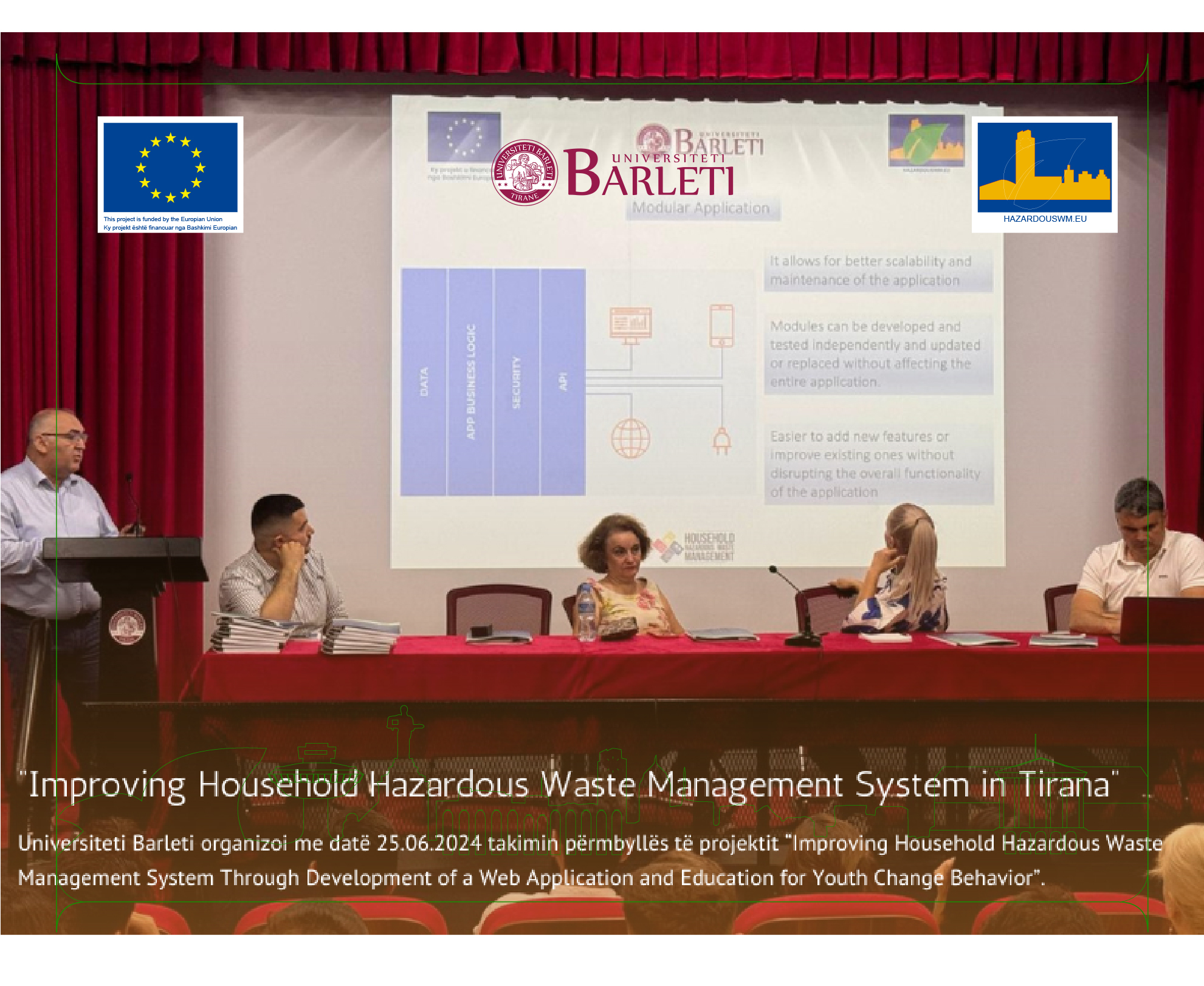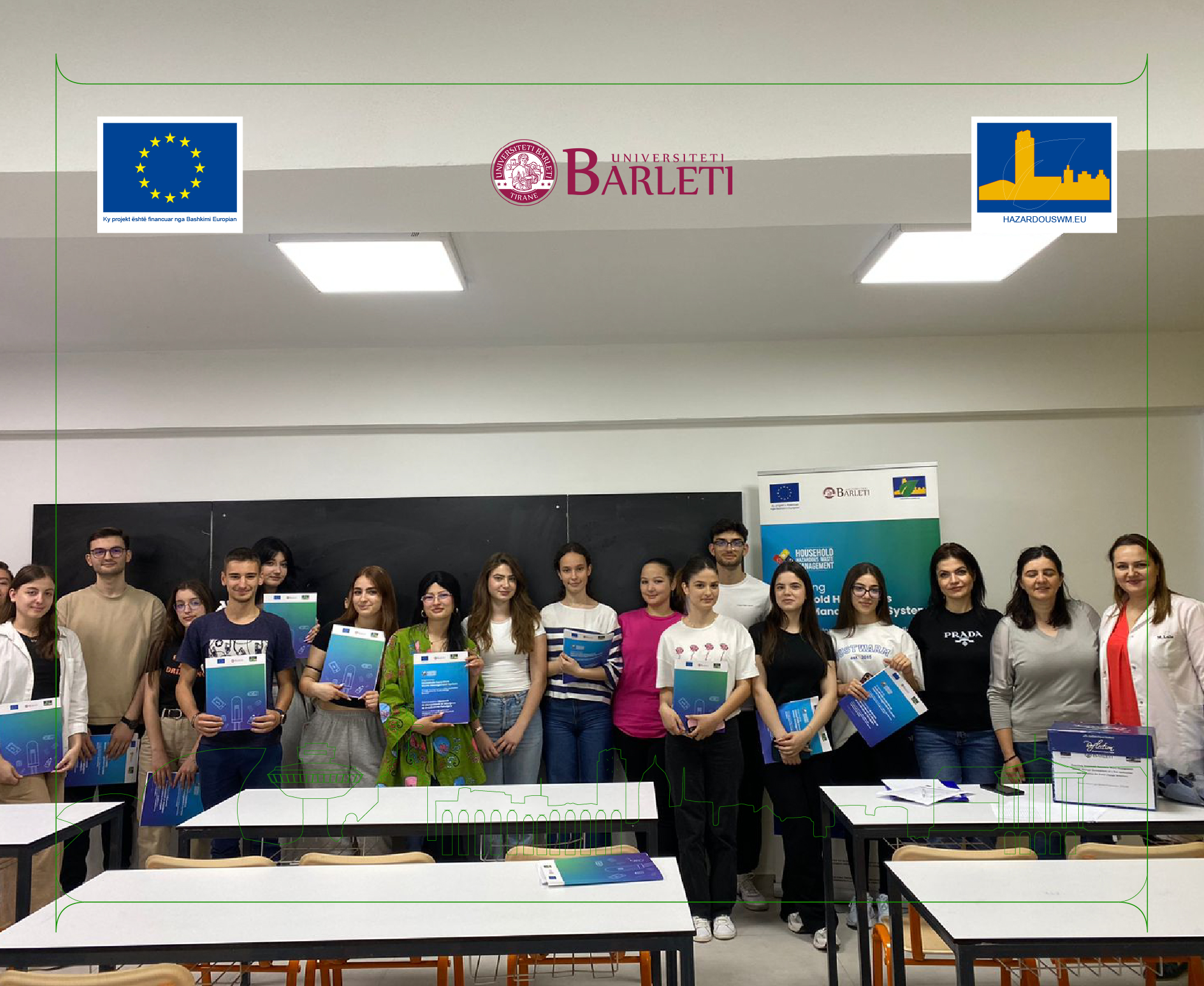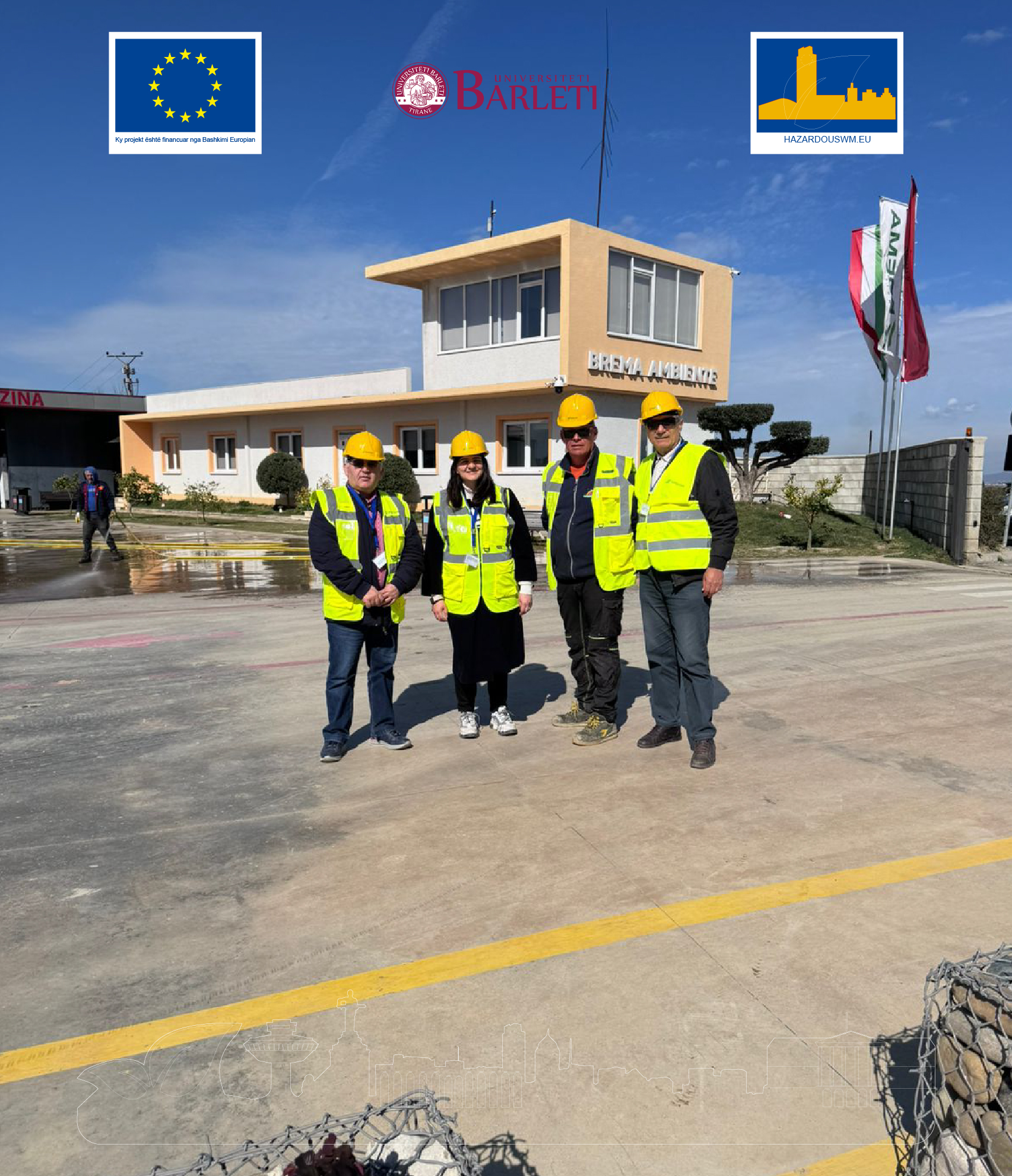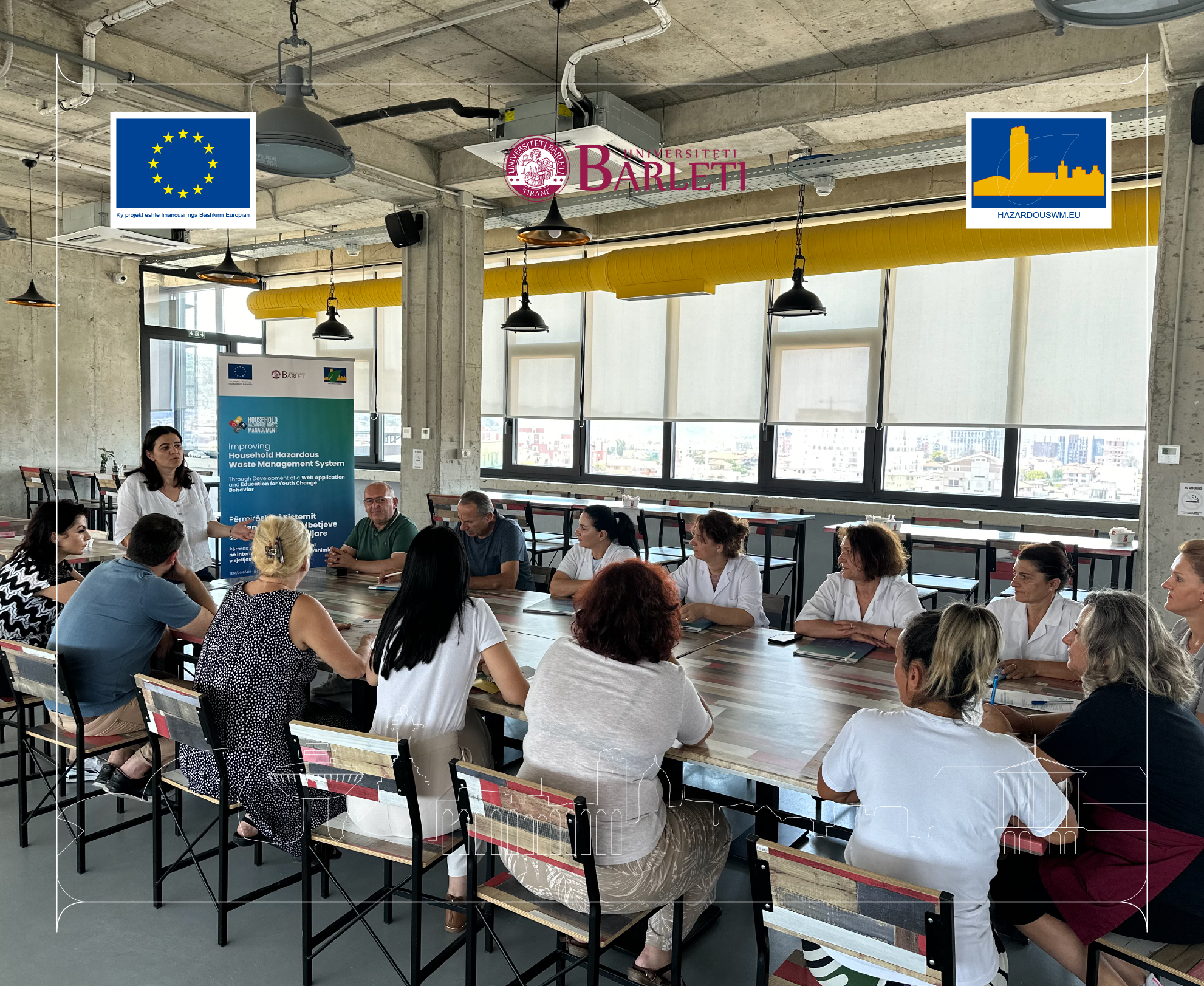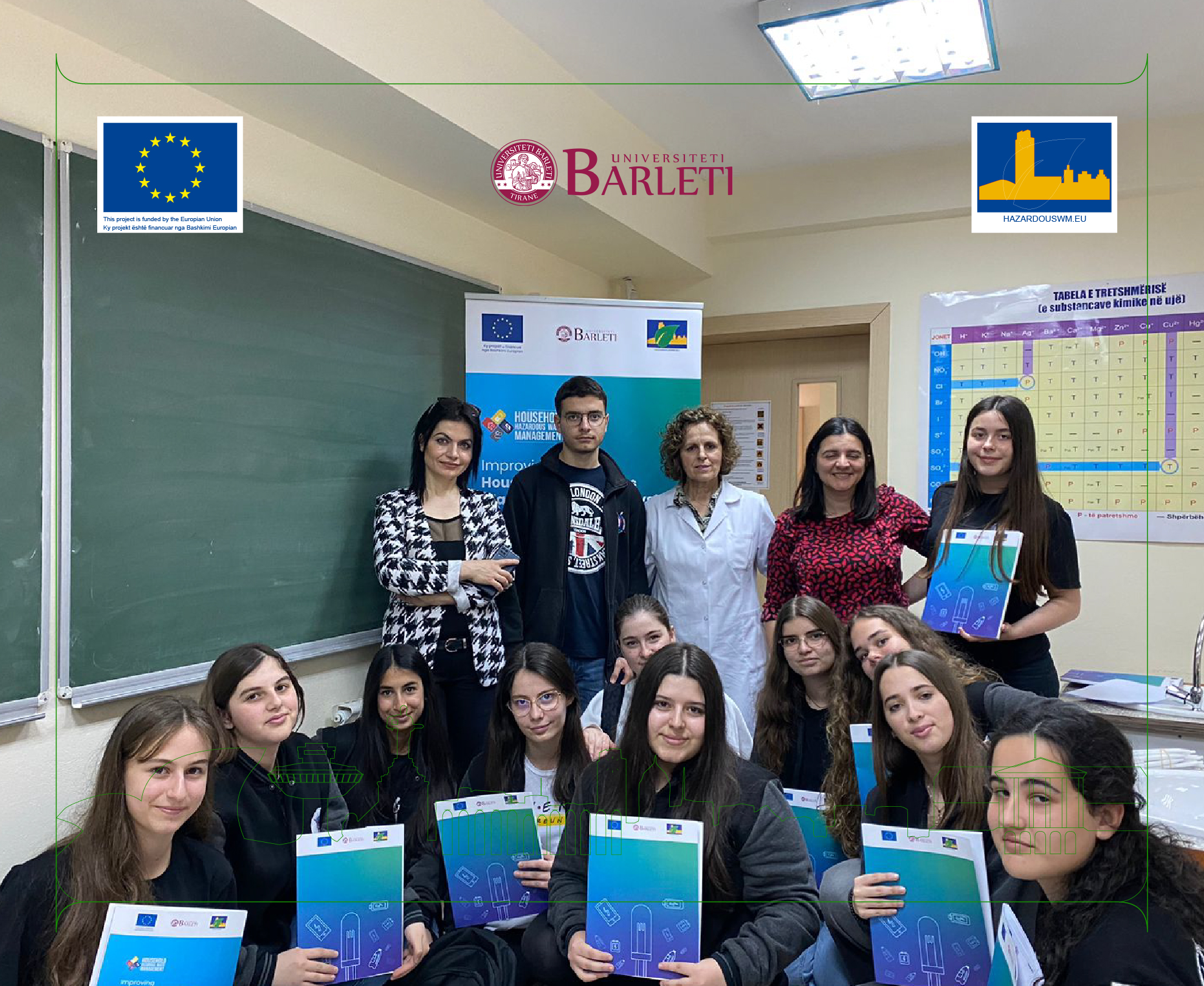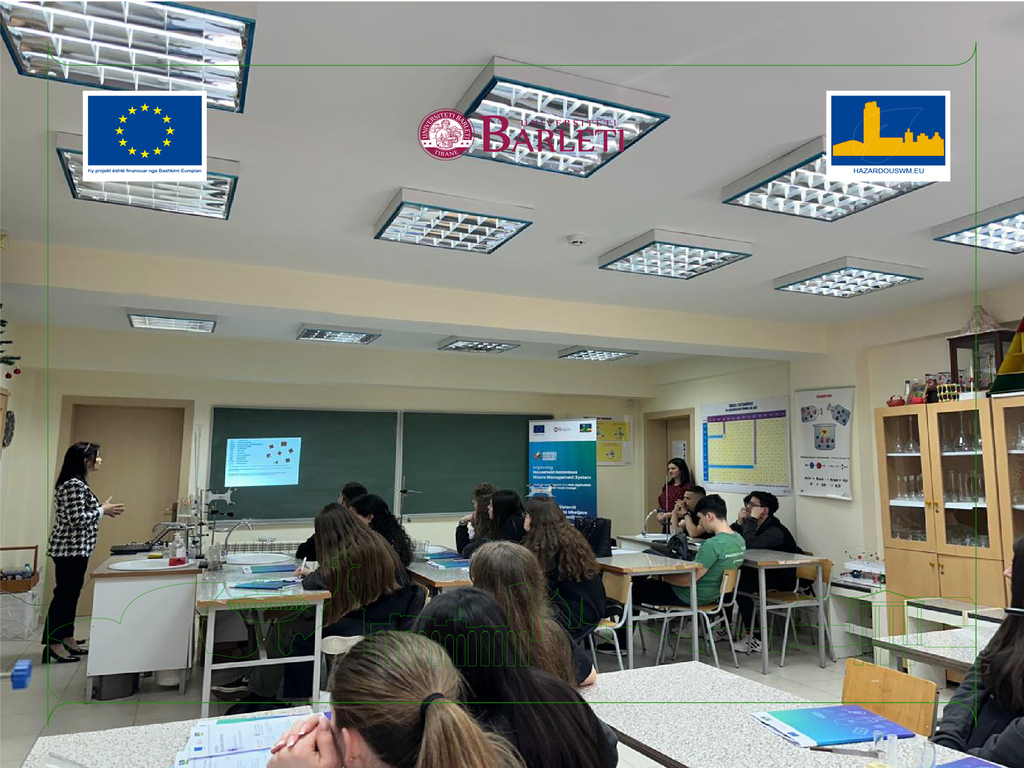Shaping a circular industrial ecosystem and supporting life-cycle thinking
Household Hazardous Waste Management
Improving Household Hazardous Waste Management System Through Development of a Web Application
Proper management of HHW not only helps protect the environment and reduce the toxicity of landfill leachate, but it also provides citizens an opportunity to rid their homes of potentially dangerous chemicals. The project was built into two pillars: (1) developing and introducing innovation and digital (online) application in HHWM, and (2) Improving patterns of youth behavior towards HHW through education and training (establishment of Tirana Schools Lab Rehab Program).
Albania
Local
Tirana
Mainly rural
It refers to other types of transformations (soft investment)
Yes
2024-06-30
Yes
Capital Cities Collaborating on Common Challenges in Hazardous Waste Management – Yerevan, Warsaw, Tirana
FINANCIAL SUPPORT TO THIRD PARTIES: INNOVATION GRANTS FOR MUNICIPAL WASTE MANAGEMENT - Reference: ENI/2019/412-943/SG3
No
No
As a representative of an organisation
The proposed project aims to improve household hazardous waste management (HHWM) in Tirana by integrating digital solutions and fostering behavioral change among youth. It focuses on two main pillars: (1) developing an innovative digital application for HHWM and (2) educating and engaging young people through the Tirana Schools Lab Rehab Program (TSLRP).
The target groups include Tirana’s citizens, local government authorities, environmental agencies, waste management companies, and educational institutions. The project seeks to empower both institutional users, such as the Municipality of Tirana and the National Environmental Agency, and end users, including households, school communities, and waste management stakeholders.
The specific objectives of the project are to enhance HHW collection, transportation, and disposal operations by introducing a modular and adaptive mobile application. The app will help users identify hazardous waste categories, provide disposal guidelines, and locate the nearest collection points using real-time mapping. Additionally, it will include features like QR code scanning for hazardous product identification, real-time reporting of HHW locations, and safety guidelines.
Through TSLRP, the project also aims to educate students and teachers on chemical safety practices and hazardous waste disposal in public schools, fostering a safer and more sustainable learning environment.
The achieved outcomes include the development of a functional digital HHWM platform that improves public awareness and participation, facilitates more efficient waste collection, and minimizes environmental hazards. Furthermore, the project strengthens governance by increasing community engagement in HHWM, supports environmental sustainability by reducing HHW contamination, and empowers youth by providing them with education and hands-on experience in green chemistry and safe waste disposal practices.
The target groups include Tirana’s citizens, local government authorities, environmental agencies, waste management companies, and educational institutions. The project seeks to empower both institutional users, such as the Municipality of Tirana and the National Environmental Agency, and end users, including households, school communities, and waste management stakeholders.
The specific objectives of the project are to enhance HHW collection, transportation, and disposal operations by introducing a modular and adaptive mobile application. The app will help users identify hazardous waste categories, provide disposal guidelines, and locate the nearest collection points using real-time mapping. Additionally, it will include features like QR code scanning for hazardous product identification, real-time reporting of HHW locations, and safety guidelines.
Through TSLRP, the project also aims to educate students and teachers on chemical safety practices and hazardous waste disposal in public schools, fostering a safer and more sustainable learning environment.
The achieved outcomes include the development of a functional digital HHWM platform that improves public awareness and participation, facilitates more efficient waste collection, and minimizes environmental hazards. Furthermore, the project strengthens governance by increasing community engagement in HHWM, supports environmental sustainability by reducing HHW contamination, and empowers youth by providing them with education and hands-on experience in green chemistry and safe waste disposal practices.
Household Hazardous Waste Management
Digital Innovation
Environmental Sustainability
Community Engagement
Youth Education
The project’s key objectives align with sustainability principles by promoting effective hazardous waste management, digital innovation, environmental awareness, and community engagement. The primary sustainability goals include reducing environmental contamination from household hazardous waste (HHW), improving waste collection efficiency, and fostering long-term behavioral change among youth and communities.
To achieve these, the project developed a modular and adaptive digital platform that enhances HHW identification, collection, and disposal. This innovation reduces improper waste disposal, minimizes pollution, and optimizes resource use, contributing to circular economy principles. The platform’s real-time mapping, QR code scanning for hazardous product identification, and reporting tools empower citizens and waste management authorities to improve efficiency and accountability in HHW disposal.
Additionally, through the Tirana Schools Lab Rehab Program (TSLRP), the project fosters sustainability by educating students and teachers on chemical safety, green chemistry, and responsible waste disposal practices. This initiative instills a culture of environmental stewardship and promotes long-term sustainable behavior among future generations.
The project stands as an exemplary model for integrating digital solutions with sustainability education, demonstrating how technology and awareness campaigns can drive positive environmental change. By combining public participation, institutional collaboration, and digital tools, it ensures a scalable, adaptable, and replicable approach to HHW management that can be adopted in other urban settings.
To achieve these, the project developed a modular and adaptive digital platform that enhances HHW identification, collection, and disposal. This innovation reduces improper waste disposal, minimizes pollution, and optimizes resource use, contributing to circular economy principles. The platform’s real-time mapping, QR code scanning for hazardous product identification, and reporting tools empower citizens and waste management authorities to improve efficiency and accountability in HHW disposal.
Additionally, through the Tirana Schools Lab Rehab Program (TSLRP), the project fosters sustainability by educating students and teachers on chemical safety, green chemistry, and responsible waste disposal practices. This initiative instills a culture of environmental stewardship and promotes long-term sustainable behavior among future generations.
The project stands as an exemplary model for integrating digital solutions with sustainability education, demonstrating how technology and awareness campaigns can drive positive environmental change. By combining public participation, institutional collaboration, and digital tools, it ensures a scalable, adaptable, and replicable approach to HHW management that can be adopted in other urban settings.
The project integrates aesthetic and user-centered design principles to enhance public engagement and ensure a seamless, intuitive experience for users. The key objective is to create a visually appealing, accessible, and culturally relevant digital platform that encourages participation in household hazardous waste management (HHWM) while promoting sustainability through education and community involvement.
The mobile application is designed with a clean, modern interface, incorporating interactive mapping, QR code scanning, and real-time reporting features. The intuitive navigation and visually engaging design elements ensure that users of all ages and backgrounds can easily understand and utilize the platform. Color schemes and icons are carefully chosen to distinguish hazardous waste categories, making waste identification simple and effective.
Beyond digital aesthetics, the project enhances the physical and cultural environment by incorporating Tirana’s urban identity and community values. Through the Tirana Schools Lab Rehab Program (TSLRP), students engage in creative, hands-on learning experiences that blend science, environmental awareness, and cultural expression. Interactive workshops, artistic displays, and storytelling methods help communicate the importance of HHWM in a way that resonates with local communities.
This project serves as an exemplary model by demonstrating how aesthetic design, cultural relevance, and innovative technology can transform public perceptions of waste management. By making HHWM more engaging and integrating educational and cultural dimensions, it fosters a positive and lasting impact on environmental behavior while enhancing the quality of urban life.
The mobile application is designed with a clean, modern interface, incorporating interactive mapping, QR code scanning, and real-time reporting features. The intuitive navigation and visually engaging design elements ensure that users of all ages and backgrounds can easily understand and utilize the platform. Color schemes and icons are carefully chosen to distinguish hazardous waste categories, making waste identification simple and effective.
Beyond digital aesthetics, the project enhances the physical and cultural environment by incorporating Tirana’s urban identity and community values. Through the Tirana Schools Lab Rehab Program (TSLRP), students engage in creative, hands-on learning experiences that blend science, environmental awareness, and cultural expression. Interactive workshops, artistic displays, and storytelling methods help communicate the importance of HHWM in a way that resonates with local communities.
This project serves as an exemplary model by demonstrating how aesthetic design, cultural relevance, and innovative technology can transform public perceptions of waste management. By making HHWM more engaging and integrating educational and cultural dimensions, it fosters a positive and lasting impact on environmental behavior while enhancing the quality of urban life.
The project is designed to be inclusive and accessible to all societal groups, ensuring that household hazardous waste management (HHWM) becomes an affordable, user-friendly, and community-driven process. The key objectives focus on universal accessibility, affordability, participatory governance, and inclusive education, making waste management a shared responsibility across different demographics.
To ensure digital inclusion, the mobile application is designed with a user-friendly interface, incorporating clear visual guides, multilingual options, and intuitive navigation to accommodate users of all ages and backgrounds. Special attention is given to making the platform accessible to individuals with disabilities by integrating read-aloud features and high-contrast visuals. Moreover, the application is free to use, removing economic barriers to participation.
The Tirana Schools Lab Rehab Program (TSLRP) fosters educational inclusion, engaging students from diverse socio-economic backgrounds in hands-on learning about hazardous waste disposal, green chemistry, and environmental responsibility. This ensures that future generations, regardless of social status, are empowered with knowledge and skills to contribute to sustainability efforts.
In terms of governance, the project promotes inclusive decision-making by involving local authorities, environmental agencies, schools, and community members in the co-creation of waste management solutions. By integrating crowdsourced data from citizens through the digital platform, the system ensures that all community voices are heard and considered in HHWM policies.
This project stands as an exemplary model for how digital solutions, participatory governance, and inclusive education can democratize environmental responsibility. By making HHWM affordable, accessible, and community-driven, it establishes a replicable framework for cities striving for equitable and sustainable waste management systems.
To ensure digital inclusion, the mobile application is designed with a user-friendly interface, incorporating clear visual guides, multilingual options, and intuitive navigation to accommodate users of all ages and backgrounds. Special attention is given to making the platform accessible to individuals with disabilities by integrating read-aloud features and high-contrast visuals. Moreover, the application is free to use, removing economic barriers to participation.
The Tirana Schools Lab Rehab Program (TSLRP) fosters educational inclusion, engaging students from diverse socio-economic backgrounds in hands-on learning about hazardous waste disposal, green chemistry, and environmental responsibility. This ensures that future generations, regardless of social status, are empowered with knowledge and skills to contribute to sustainability efforts.
In terms of governance, the project promotes inclusive decision-making by involving local authorities, environmental agencies, schools, and community members in the co-creation of waste management solutions. By integrating crowdsourced data from citizens through the digital platform, the system ensures that all community voices are heard and considered in HHWM policies.
This project stands as an exemplary model for how digital solutions, participatory governance, and inclusive education can democratize environmental responsibility. By making HHWM affordable, accessible, and community-driven, it establishes a replicable framework for cities striving for equitable and sustainable waste management systems.
The project actively involves citizens, local communities, and civil society organizations to ensure a collaborative and impactful approach to household hazardous waste management (HHWM). Their participation is fundamental in shaping a more efficient, inclusive, and sustainable waste management system.
Citizens benefit from the project through improved access to HHWM services, an easy-to-use digital platform, and educational programs that enhance awareness of hazardous waste disposal. The mobile application empowers residents by allowing them to identify HHW, report disposal issues, and locate collection points in real time. Their direct engagement in reporting and monitoring hazardous waste increases accountability and responsiveness from waste management authorities.
The role of civil society organizations (CSOs) is central in promoting community awareness and advocating for better HHWM policies. CSOs contribute by facilitating workshops, mobilizing community participation, and disseminating educational materials. Their involvement ensures that the project aligns with the needs of vulnerable groups and fosters a culture of shared environmental responsibility.
Through the Tirana Schools Lab Rehab Program (TSLRP), students, teachers, and parents play a key role in co-creating solutions for safer school environments. By integrating HHWM education into schools, the project promotes long-term behavioral change among younger generations.
The impact of this involvement has been significant, leading to increased public awareness, more efficient waste reporting, and stronger community engagement. The project has built a sense of shared ownership, where citizens and civil society are not just passive beneficiaries but active contributors to a sustainable and inclusive waste management system.
Citizens benefit from the project through improved access to HHWM services, an easy-to-use digital platform, and educational programs that enhance awareness of hazardous waste disposal. The mobile application empowers residents by allowing them to identify HHW, report disposal issues, and locate collection points in real time. Their direct engagement in reporting and monitoring hazardous waste increases accountability and responsiveness from waste management authorities.
The role of civil society organizations (CSOs) is central in promoting community awareness and advocating for better HHWM policies. CSOs contribute by facilitating workshops, mobilizing community participation, and disseminating educational materials. Their involvement ensures that the project aligns with the needs of vulnerable groups and fosters a culture of shared environmental responsibility.
Through the Tirana Schools Lab Rehab Program (TSLRP), students, teachers, and parents play a key role in co-creating solutions for safer school environments. By integrating HHWM education into schools, the project promotes long-term behavioral change among younger generations.
The impact of this involvement has been significant, leading to increased public awareness, more efficient waste reporting, and stronger community engagement. The project has built a sense of shared ownership, where citizens and civil society are not just passive beneficiaries but active contributors to a sustainable and inclusive waste management system.
The project engaged a diverse range of stakeholders at local, regional, national, and European levels, ensuring a collaborative and multi-level approach to household hazardous waste management (HHWM). Their active participation in the design and implementation of the project has significantly enriched its impact and sustainability.
At the local level, the Municipality of Tirana and the National Environmental Agency played a key role in policy alignment, logistical support, and integration of the digital HHWM platform into existing waste management frameworks. Local schools and educational institutions were engaged through the Tirana Schools Lab Rehab Program (TSLRP), fostering awareness and behavioral change among students. Civil society organizations (CSOs) and community groups contributed by facilitating citizen engagement, awareness campaigns, and workshops to ensure broad community participation.
At the regional level, waste management companies and environmental agencies collaborated in piloting and optimizing the digital HHWM platform, ensuring that collection and disposal processes were effectively implemented. Regional authorities also provided technical expertise to improve hazardous waste tracking and disposal efficiency.
At the national level, the Ministry of Tourism and Environment supported the project by aligning it with national waste management strategies and integrating best practices for hazardous waste governance. National research institutions contributed by providing data and expertise on environmental risks and HHWM innovations.
The added value of this multi-level engagement lies in its ability to integrate policy, technology, and community participation, creating a scalable and replicable model for hazardous waste management. By involving stakeholders from different levels, the project has ensured greater efficiency, long-term sustainability, and wider adoption of its digital and educational innovations.
At the local level, the Municipality of Tirana and the National Environmental Agency played a key role in policy alignment, logistical support, and integration of the digital HHWM platform into existing waste management frameworks. Local schools and educational institutions were engaged through the Tirana Schools Lab Rehab Program (TSLRP), fostering awareness and behavioral change among students. Civil society organizations (CSOs) and community groups contributed by facilitating citizen engagement, awareness campaigns, and workshops to ensure broad community participation.
At the regional level, waste management companies and environmental agencies collaborated in piloting and optimizing the digital HHWM platform, ensuring that collection and disposal processes were effectively implemented. Regional authorities also provided technical expertise to improve hazardous waste tracking and disposal efficiency.
At the national level, the Ministry of Tourism and Environment supported the project by aligning it with national waste management strategies and integrating best practices for hazardous waste governance. National research institutions contributed by providing data and expertise on environmental risks and HHWM innovations.
The added value of this multi-level engagement lies in its ability to integrate policy, technology, and community participation, creating a scalable and replicable model for hazardous waste management. By involving stakeholders from different levels, the project has ensured greater efficiency, long-term sustainability, and wider adoption of its digital and educational innovations.
The project was designed and implemented through a multidisciplinary approach, integrating expertise from environmental science, digital technology, education, public policy, and community engagement. The collaboration among these diverse fields ensured a holistic and innovative solution for household hazardous waste management (HHWM).
Environmental science and waste management experts played a crucial role in identifying hazardous waste categories, risk factors, and best disposal practices. Their insights helped shape the mobile application’s functionalities and provided guidelines for sustainable HHWM strategies.
Digital technology specialists developed the modular and adaptive digital platform, incorporating QR code scanning, real-time reporting, and interactive mapping to enhance public participation and improve waste tracking efficiency. Their expertise ensured that the platform was user-friendly, accessible, and responsive to community needs.
Education and behavioral science experts contributed through the Tirana Schools Lab Rehab Program (TSLRP), designing interactive learning modules to educate students and teachers about hazardous waste risks.
Public policy and governance professionals ensured that the project aligned with local and national waste management policies, facilitating integration with national environmental frameworks.
Community engagement specialists and civil society organizations (CSOs) were actively involved in awareness campaigns, stakeholder coordination, and public engagement initiatives.
The added value of this interdisciplinary collaboration was the creation of a scalable and replicable model for HHWM that balances technological innovation, environmental responsibility, and community empowerment. By integrating expertise from multiple fields, the project successfully bridged scientific research, technological advancements, policy frameworks, and grassroots participation, ensuring its effectiveness and long-term sustainability
Environmental science and waste management experts played a crucial role in identifying hazardous waste categories, risk factors, and best disposal practices. Their insights helped shape the mobile application’s functionalities and provided guidelines for sustainable HHWM strategies.
Digital technology specialists developed the modular and adaptive digital platform, incorporating QR code scanning, real-time reporting, and interactive mapping to enhance public participation and improve waste tracking efficiency. Their expertise ensured that the platform was user-friendly, accessible, and responsive to community needs.
Education and behavioral science experts contributed through the Tirana Schools Lab Rehab Program (TSLRP), designing interactive learning modules to educate students and teachers about hazardous waste risks.
Public policy and governance professionals ensured that the project aligned with local and national waste management policies, facilitating integration with national environmental frameworks.
Community engagement specialists and civil society organizations (CSOs) were actively involved in awareness campaigns, stakeholder coordination, and public engagement initiatives.
The added value of this interdisciplinary collaboration was the creation of a scalable and replicable model for HHWM that balances technological innovation, environmental responsibility, and community empowerment. By integrating expertise from multiple fields, the project successfully bridged scientific research, technological advancements, policy frameworks, and grassroots participation, ensuring its effectiveness and long-term sustainability
This project introduces a groundbreaking approach to household hazardous waste management (HHWM) by integrating digital technology, community-driven engagement, and education—a significant departure from traditional waste management practices that often rely on manual collection, limited public awareness, and fragmented disposal systems.
Unlike mainstream HHWM approaches, which typically lack real-time tracking and citizen participation, this project leverages a modular and adaptive digital platform to optimize waste collection and disposal. The mobile application features QR code scanning for hazardous product identification, real-time reporting of HHW locations, interactive mapping of collection points, and educational safety guidelines—enhancing efficiency, transparency, and accessibility for all users.
Another key innovation is the Tirana Schools Lab Rehab Program (TSLRP), which introduces youth-centered environmental education into hazardous waste management. While most HHWM strategies focus solely on waste collection, this initiative empowers students and teachers with knowledge on chemical safety, sustainable waste practices, and green chemistry, fostering long-term behavioral change at the grassroots level.
Additionally, the project pioneers a data-driven governance model by integrating crowdsourced waste reports into municipal decision-making. This participatory approach ensures a more responsive waste management system, where citizens play an active role in identifying and reporting hazardous waste issues, bridging the gap between policymakers, waste authorities, and the public.
By combining advanced digital tools, behavioral change strategies, and multi-stakeholder collaboration, this project sets a new standard for sustainable HHWM, offering a scalable and replicable model that can be adopted by other cities seeking smart, efficient, and inclusive waste management solutions.
Unlike mainstream HHWM approaches, which typically lack real-time tracking and citizen participation, this project leverages a modular and adaptive digital platform to optimize waste collection and disposal. The mobile application features QR code scanning for hazardous product identification, real-time reporting of HHW locations, interactive mapping of collection points, and educational safety guidelines—enhancing efficiency, transparency, and accessibility for all users.
Another key innovation is the Tirana Schools Lab Rehab Program (TSLRP), which introduces youth-centered environmental education into hazardous waste management. While most HHWM strategies focus solely on waste collection, this initiative empowers students and teachers with knowledge on chemical safety, sustainable waste practices, and green chemistry, fostering long-term behavioral change at the grassroots level.
Additionally, the project pioneers a data-driven governance model by integrating crowdsourced waste reports into municipal decision-making. This participatory approach ensures a more responsive waste management system, where citizens play an active role in identifying and reporting hazardous waste issues, bridging the gap between policymakers, waste authorities, and the public.
By combining advanced digital tools, behavioral change strategies, and multi-stakeholder collaboration, this project sets a new standard for sustainable HHWM, offering a scalable and replicable model that can be adopted by other cities seeking smart, efficient, and inclusive waste management solutions.
The project employs a multi-disciplinary, technology-driven, and community-centered approach to household hazardous waste management (HHWM), integrating digital innovation, education, and participatory governance.
The first phase involved research and stakeholder engagement, where municipal authorities, waste management experts, environmental agencies, and community organizations were consulted to assess HHWM challenges and define key functionalities for the digital platform. Simultaneously, an analysis of hazardous waste types, disposal practices, and existing regulatory frameworks was conducted to ensure compliance and effectiveness.
The second phase focused on developing and implementing the digital HHWM platform, designed with a user-friendly interface, QR code scanning, real-time waste reporting, interactive mapping, and educational tools. To ensure accessibility, the platform was tested with local communities and waste authorities, with feedback incorporated for optimization.
Parallel to the technological component, the Tirana Schools Lab Rehab Program (TSLRP) was launched to integrate hazardous waste education into schools. This phase included teacher training, student workshops, and interactive learning materials on green chemistry, chemical safety, and sustainable waste disposal.
The final phase emphasized community engagement and policy integration. Public awareness campaigns and training sessions encouraged citizens to use the platform and report HHW, while municipal authorities integrated crowdsourced data into decision-making processes. The project’s impact was assessed through usage metrics, stakeholder feedback, and environmental impact evaluations.
By combining data-driven technology, participatory governance, and environmental education, the project provides a replicable and scalable model for sustainable HHWM, setting a new standard for waste management in urban settings.
The first phase involved research and stakeholder engagement, where municipal authorities, waste management experts, environmental agencies, and community organizations were consulted to assess HHWM challenges and define key functionalities for the digital platform. Simultaneously, an analysis of hazardous waste types, disposal practices, and existing regulatory frameworks was conducted to ensure compliance and effectiveness.
The second phase focused on developing and implementing the digital HHWM platform, designed with a user-friendly interface, QR code scanning, real-time waste reporting, interactive mapping, and educational tools. To ensure accessibility, the platform was tested with local communities and waste authorities, with feedback incorporated for optimization.
Parallel to the technological component, the Tirana Schools Lab Rehab Program (TSLRP) was launched to integrate hazardous waste education into schools. This phase included teacher training, student workshops, and interactive learning materials on green chemistry, chemical safety, and sustainable waste disposal.
The final phase emphasized community engagement and policy integration. Public awareness campaigns and training sessions encouraged citizens to use the platform and report HHW, while municipal authorities integrated crowdsourced data into decision-making processes. The project’s impact was assessed through usage metrics, stakeholder feedback, and environmental impact evaluations.
By combining data-driven technology, participatory governance, and environmental education, the project provides a replicable and scalable model for sustainable HHWM, setting a new standard for waste management in urban settings.
Several key elements of this project can be replicated and adapted to different locations, beneficiary groups, and contexts, making it a scalable and transferable model for household hazardous waste management (HHWM).
The digital HHWM platform is one of the most adaptable components. Its modular and customizable design allows it to be implemented in other cities or regions with minimal adjustments. Features such as QR code scanning for hazardous product identification, real-time waste reporting, interactive mapping of collection points, and educational resources can be tailored to fit local waste management policies and infrastructure.
The Tirana Schools Lab Rehab Program (TSLRP) can also be transferred to other educational institutions and community programs. Its focus on youth engagement, green chemistry, and hazardous waste awareness makes it relevant across different urban and rural settings. Schools in other municipalities can integrate its curriculum, workshops, and teacher training into their environmental education initiatives.
The participatory governance approach, which encourages citizen involvement in waste monitoring and policy feedback, is another replicable aspect. Municipalities can leverage crowdsourced data from the digital platform to improve waste collection strategies and engage communities in decision-making. This approach enhances transparency, accountability, and responsiveness in urban waste management.
Furthermore, the methodology combining technology, education, and multi-stakeholder collaboration can be applied to other waste management challenges, circular economy initiatives, and environmental monitoring programs. By adapting the technology and engagement model, other cities can modernize their waste management systems, making them more efficient, inclusive, and sustainable.
The digital HHWM platform is one of the most adaptable components. Its modular and customizable design allows it to be implemented in other cities or regions with minimal adjustments. Features such as QR code scanning for hazardous product identification, real-time waste reporting, interactive mapping of collection points, and educational resources can be tailored to fit local waste management policies and infrastructure.
The Tirana Schools Lab Rehab Program (TSLRP) can also be transferred to other educational institutions and community programs. Its focus on youth engagement, green chemistry, and hazardous waste awareness makes it relevant across different urban and rural settings. Schools in other municipalities can integrate its curriculum, workshops, and teacher training into their environmental education initiatives.
The participatory governance approach, which encourages citizen involvement in waste monitoring and policy feedback, is another replicable aspect. Municipalities can leverage crowdsourced data from the digital platform to improve waste collection strategies and engage communities in decision-making. This approach enhances transparency, accountability, and responsiveness in urban waste management.
Furthermore, the methodology combining technology, education, and multi-stakeholder collaboration can be applied to other waste management challenges, circular economy initiatives, and environmental monitoring programs. By adapting the technology and engagement model, other cities can modernize their waste management systems, making them more efficient, inclusive, and sustainable.
This project tackles critical global environmental challenges by implementing localized, technology-driven solutions for household hazardous waste management (HHWM). The key global issues addressed include waste pollution, climate change, public health risks, and the need for circular economy practices.
One of the major global challenges is hazardous waste mismanagement, which leads to soil, water, and air contamination. Improper disposal of toxic chemicals, batteries, e-waste, and pharmaceuticals threatens ecosystems and public health. The project provides a local solution by developing a digital HHWM platform, enabling real-time waste reporting, tracking, and proper disposal guidance, thereby reducing pollution and promoting responsible waste management.
Another challenge is climate change, where waste-related emissions, including toxic fumes from burned hazardous materials, contribute to environmental degradation. By optimizing HHWM processes through digital mapping and participatory governance, the project helps reduce uncontrolled waste dumping and emissions, contributing to climate resilience at the community level.
Public health risks associated with exposure to hazardous waste disproportionately affect urban populations and vulnerable groups. Through the Tirana Schools Lab Rehab Program (TSLRP), the project addresses this challenge locally by educating students and teachers on chemical safety, green chemistry, and sustainable waste disposal, ensuring long-term behavioral change and reducing health hazards.
The project also supports the global transition to a circular economy by promoting waste reduction, responsible consumption, and improved waste processing systems. The scalable and adaptable nature of the digital platform and educational model makes it a replicable best practice, demonstrating how smart technology, education, and citizen engagement can create lasting environmental solutions at both local and global levels
One of the major global challenges is hazardous waste mismanagement, which leads to soil, water, and air contamination. Improper disposal of toxic chemicals, batteries, e-waste, and pharmaceuticals threatens ecosystems and public health. The project provides a local solution by developing a digital HHWM platform, enabling real-time waste reporting, tracking, and proper disposal guidance, thereby reducing pollution and promoting responsible waste management.
Another challenge is climate change, where waste-related emissions, including toxic fumes from burned hazardous materials, contribute to environmental degradation. By optimizing HHWM processes through digital mapping and participatory governance, the project helps reduce uncontrolled waste dumping and emissions, contributing to climate resilience at the community level.
Public health risks associated with exposure to hazardous waste disproportionately affect urban populations and vulnerable groups. Through the Tirana Schools Lab Rehab Program (TSLRP), the project addresses this challenge locally by educating students and teachers on chemical safety, green chemistry, and sustainable waste disposal, ensuring long-term behavioral change and reducing health hazards.
The project also supports the global transition to a circular economy by promoting waste reduction, responsible consumption, and improved waste processing systems. The scalable and adaptable nature of the digital platform and educational model makes it a replicable best practice, demonstrating how smart technology, education, and citizen engagement can create lasting environmental solutions at both local and global levels
The project has achieved significant results, outcomes, and long-term impacts in the field of household hazardous waste management (HHWM), aligning with the category applied for. It has successfully improved waste collection efficiency, increased public awareness, and promoted behavioral change, benefiting both direct and indirect stakeholders.
Among the key results, the project developed an innovative digital HHWM platform that enables real-time waste tracking, QR code-based hazardous product identification, interactive mapping of collection points, and citizen reporting features. This has enhanced waste disposal efficiency while increasing community participation.
Through the Tirana Schools Lab Rehab Program (TSLRP), the project successfully educated students, teachers, and school staff on green chemistry, hazardous waste safety, and sustainable disposal methods. This initiative has not only improved chemical safety in schools but also fostered a culture of environmental responsibility among young people.
The outcomes include a better-informed public, improved waste collection coordination between municipalities and environmental agencies, and an overall reduction in hazardous waste mismanagement. Municipalities and waste authorities now have access to crowdsourced data, allowing for more responsive and data-driven decision-making. In terms of impact, the project has empowered communities, strengthened environmental governance, and contributed to the reduction of waste-related health hazards. Direct beneficiaries include households, students, educational institutions, waste management authorities, and policymakers, while indirect beneficiaries include local businesses, environmental NGOs, and the broader urban population.
This project stands as a scalable, replicable model for other cities and regions, demonstrating how digital tools, participatory governance, and education can drive long-term improvements in HHWM and environmental sustainability
Among the key results, the project developed an innovative digital HHWM platform that enables real-time waste tracking, QR code-based hazardous product identification, interactive mapping of collection points, and citizen reporting features. This has enhanced waste disposal efficiency while increasing community participation.
Through the Tirana Schools Lab Rehab Program (TSLRP), the project successfully educated students, teachers, and school staff on green chemistry, hazardous waste safety, and sustainable disposal methods. This initiative has not only improved chemical safety in schools but also fostered a culture of environmental responsibility among young people.
The outcomes include a better-informed public, improved waste collection coordination between municipalities and environmental agencies, and an overall reduction in hazardous waste mismanagement. Municipalities and waste authorities now have access to crowdsourced data, allowing for more responsive and data-driven decision-making. In terms of impact, the project has empowered communities, strengthened environmental governance, and contributed to the reduction of waste-related health hazards. Direct beneficiaries include households, students, educational institutions, waste management authorities, and policymakers, while indirect beneficiaries include local businesses, environmental NGOs, and the broader urban population.
This project stands as a scalable, replicable model for other cities and regions, demonstrating how digital tools, participatory governance, and education can drive long-term improvements in HHWM and environmental sustainability

